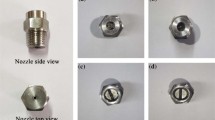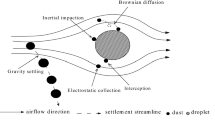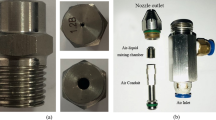Abstract
In this study, experimental studies on atomization process and dust reduction performance of four swirl nozzles with different inlet/outlet diameter ratio (D) were performed. The results of the atomization process study of the nozzle show that with the increase of D, the droplet breakup range of the spray field is gradually increasing, but the droplet breakup intensity of the spray field is gradually decreasing. At D = 3.33 and 3.63, droplet breakup occurs mainly in the range of 0–4 mm in the strong turbulent region. At D = 3.75, droplet breakup occurs mainly in the range of 0–2 mm in the strong turbulent region. At D = 3.96, droplet breakup occurs mainly in the range of 0–1 mm in the strong turbulent region. Droplet breakup in the spray field at D = 3.33 and D = 3.67 was better than that at D = 3.75 and D = 3.96. From the dust reduction experimental results, the dust reduction efficiency increases and then decreases with the increase of D. The dust reduction efficiency is highest among the four nozzles at D = 3.67. Based on the dust reduction curves of four different D of nozzles, it is predicted that the optimal dust reduction condition will be achieved at D of 3.60, which provides a reference for the design and optimization of nozzles.
Graphical abstract


















Similar content being viewed by others
Data availability
Not applicable.
References
Andersson R, Andersson B (2006) Modeling the breakup of fluid particles in turbulent flows. AIChE J 52(6):2031–2038
Dejuhasz KJ (1931) Dispersion of sprays in solid Injection Oil Engines. ASME 53:65
Dong Q, Ishima T, Kawashima H, Long W (2013) A study on the spray characteristics of a piezo pintle-type injector for DI gasoline engines. J Mech Sci Technol 27(7)
Galinat S, Masbernat O, Guiraud P, Dalmazzone C, Nor C (2005) Drop break-up in turbulent pipe flow downstream of a restriction. Chem Eng Sci 60:6511–6528
Gelfand B (1996) Droplet breakup phenomena in flows with velocity lag. Prog Energy Combust 22:201–265
Hill H, Ding CP, Baum E, Böhm B, Dreizler A, Peterson B (2019) An application of tomographic PIV to investigate the spray-induced turbulence in a direct-injection engine. Int J Multiphase Flow 121:103–116
Hinze JO (1955) Fundamentals of the hydrodynamic mechanism of splitting in dispersion processes. AIChE J 1:289–295
Ishimoto J, Hoshina H, Tsuchiyama T et al (2007) Integrated simulation of the atomization process of a liquid jet through a cylindrical nozzle. Interdiscip Inf Sci 13(1):7–16
Jing D, Jia X, Ge S, Zhang T, Ma M (2021) Numerical simulation and experimental study of vortex blowing suction dust control in a coal yard with multiple dust production points. Powder Technol 388:554–565
Kolmogorov AN (1949) On the disintegration of drops in a turbulent flow. Dokl Akad Nauk SSSR 66:825–828
Li M, Zhao G (2014) High pressure spray nozzle design and parameter optimization based on finite element simulation analysis. J China Coal Soc 40(S1):279–284
Liao Y, Lucas D (2009) A literature review of theoretical models for drop and bubble breakup in turbulent dispersions. Chem Eng Sci 64:3389–3406
Liu M, Lin M, Hu S, You X, Li L (2021a) Effect of biomass surfactant on dehydration performance of low-rank coal and its mechanism. J Shandong Univ Sci Technol (Nat Sci) 40:28–37
Liu L, Ma W, Wang W (2021b) Dual damage mechanism of supercritical CO2 adsorption induced weakening effect on coal. J Shandong Univ Sci Technol (Nat Sci) 39:79–86
Moon S, Matsumoto Y, Nishida K, Gao J (2010) Gas entrainment characteristics of diesel spray injected by a group-hole nozzle. Fuel 89(11):3287–3299
Peterson B, Baum E, Ding CP, Dreizler A, Böhm B (2017) Assessment and application of tomographic PIV for the spray-induced flow in an IC engine. Proc Combust Inst 36:3467–3475
Risso F (2000) Mechanisms of deformation and breakup of drops and bubbles. Multiph Sci Technol 12:1–50
Schweitzer PH (1937) Mechanisms of disintegration of liquid jets. Jet Appl Phys 8:513
Sitkei G (1959) On the theory of jet atomization. ACAT Tech 25:87
Solsvik J, Tangen S, Jakobsen HA (2013) On the constitutive equations for fluid particle breakage. Rev Chem Eng 29:241–356
Tatyana GK, Olga VR, Irina VM et al (2019) Health risk assessment of metal(loid)s exposure via indoor dust from urban area in Chelyabinsk. Russ J Int J Geomate 16:1–7
Wang W, Jiang Z, Jushi C, Lan J, Pei C (2013) Numerical simulation analysis of inside and outside fields for nozzles with different structures. 44(11):162–165
Wang H, Wang D, Tang Y, Wang Q (2015) Foaming agent self-suction properties of a jet-type foam preparation device used in mine dust suppression. Process Saf Environ Prot 98:231–238
Wang JY, Zhou G, Wei X, Wang SC (2019) Experimental characterization of multi-nozzle atomization interference for dust reduction between hydraulic supports at a fully mechanized coal mining face. Environ Sci Pollut Res Int. https://doi.org/10.1007/s11356-019-04413-w
Wang J, Xu C, Zhang Y, Zhou G (2021) Numerical study of the effect of geometric parameters on the internal flow of a pressure nozzle for dustfall. Adv Powder Technol 32(5)
Wei X, Zhang Y, Wu G, Zhang X, Zhang Y, Wang X (2021) Study on explosion suppression of coal dust with different particle size by shell powder and NaHCO3. Fuel 306:121709
Wu Q (2007) Spray dust mechanism and efficient dust nozzle improvement study of comprehensive mechanized coal face. Liaoning university of science and technology
Wu W (2021) Coupled numerical model of hydraulic fracturing and seepage of soft coal based on elastoplastic damage. J Shandong Univ Sci Technol (Nat Sci) 40:69–76
Yao QG, Xu CC, Zhang YS, Zhou G, Zhang SC, Wang D (2017) Micro mechanism of coal dust wettability and its effect on the selection and development of dust suppressants. Process Saf Environ Prot 111:726–732
Yin WJ, Zhou G, Gao DH (2019) Simulation analysis and engineering application of distribution characteristics about multi-stage atomization field for cutting dust in fully mechanized mining face. Adv Powder Technol 30:2600–2615
Zhou Q, Qin B, Wang F, Wang H, Hou J, Wang Z (2018) Effects of droplet formation patterns on the atomization characteristics of a dust removal spray in a coal cutter. Powder Technol 344:570–580
Zhou Q, Qin BT, Wang F, Wang HT (2019) Experimental investigation on the performance of a novel magnetized apparatus used to improve the dust wetting features of surfactant-magnetized water. Powder Technol 354:149–157
Zhou G, Zhang QT, Hu YY, Gao DH, Wang SC, Sun B (2020) Dust removal effect of negatively-pressured spraying collector for advancing support in fully mechanized coal mining face: numerical simulation and engineering application. Tunnell Undergr Space Technol 95:103149
Funding
This work was financially supported by the National Natural Science Foundation of China (Grant nos. 51904171, 52004150), the Qingchuang Science and Technology Project of Universities in Shandong Province, China (Grant no. 2019KJH005), the Science and Technology Project of Qingdao City, China (Grant no. 20-3-4-2-nsh), the Outstanding Young Talents Project of Shandong University of Science and Technology (Grant no. SKR22-5-01) and the Basic Research on Air Purification and Occupational Health of Coal Mines in Shanbei Mining Area & Key Technical Equipment and Demonstration (Grant no. SMHLL-JS-YJ-2020006), the Natural Science Foundation of Shandong Provenience, China (Grant no. ZR2019BEE067).
Author information
Authors and Affiliations
Contributions
Gang Zhou: funding acquisition. Junpeng Wang: conceptualization, methodology, software, data curation, writing — original draft, writing — review and editing. Ruixin Song: investigation. Cuicui Xu: supervision, project administration. Yang Wenyu: validation.
Corresponding author
Ethics declarations
Ethical approval
I have not submitted my manuscript to a preprint server before submitting it to Environmental Science and Pollution Research.
Consent to participate
All authors read and approved the final manuscript.
Consent for publication
All authors agree to publish if the paper is accepted.
Competing interests
The authors declare no competing interests.
Additional information
Responsible Editor: Philippe Garrigues
Publisher's note
Springer Nature remains neutral with regard to jurisdictional claims in published maps and institutional affiliations.
Rights and permissions
About this article
Cite this article
Zhou, G., Wang, J., Song, R. et al. Experimental research on atomization process and dust reduction performance of swirl pressure nozzle. Environ Sci Pollut Res 29, 88540–88556 (2022). https://doi.org/10.1007/s11356-022-21394-5
Received:
Accepted:
Published:
Issue Date:
DOI: https://doi.org/10.1007/s11356-022-21394-5




